Assessment of Water Service Levels and User Satisfaction for Domestic Water Use in Emina-Boadi-Kumasi to Achieve the Sustainable Development of Urban Water Supply Systems in Ghana
Abstract
1. Introduction
2. Materials and Methods
2.1. Site Description and Location
2.2. Data Collection
2.3. Pilot Testing
2.4. Sample Size
2.5. Data Analysis
2.6. Water Service and Management
2.7. Service Level
2.8. Water Service Indicators
3. Results and Discussions
3.1. Demographic Characteristics
3.1.1. Age and Gender
3.1.2. Level of Education
3.1.3. Occupation
3.1.4. Household Size and Income
3.2. Source of Water
3.3. Quality of Water
3.4. Accessibility
3.5. Quantity
3.6. Affordability
3.7. Reliability
3.8. Relationship Between Quantity, Accessibility, Affordability, Health, and Hygiene
3.9. Enhancing Water Distribution Systems in Emina-Boadi: Practical and Community-Focused Policy Recommendations
4. Future Direction
5. Conclusions
Author Contributions
Funding
Informed Consent Statement
Data Availability Statement
Acknowledgments
Conflicts of Interest
Appendix A
- 1.
- Age of respondent
- 2.
- Gender of respondent
- 3.
- Occupation of respondent
- ■ Self Employed ■ Public Sector ■ Private ■ Retired ■ Unemployed
- 4.
- Level of education
- ■ Primary/Basic ■ JHS/JSS/Middle School ■ SHS/SSS ■ Tertiary
- 5.
- Household size
- 6.
- Household income
- 7.
- What is the main source of drinking water for your household?
- ■ Piped to dwelling ■ Piped to yard ■ Public tap/standpipe ■ Borehole/hand pipe
- ■ Protected dug well ■ unprotected dug wells ■ Bottled/sachet water ■ Tanker truck
- ■ Surface water ■ Rainfall ■ Other (Specify)
- 8.
- What is the main source of water used by your household for other purposes such as cooking and hand washing?
- ■ Piped to dwelling ■ Piped to yard ■ Public tap/standpipe ■ Borehole/hand pipe
- ■ Protected dug well ■ unprotected dug wells ■ Bottled/sachet water ■ Tanker truck
- ■ Surface water ■ Rainfall ■ Other (Specify)
- 9.
- How long does it take to go there, get water and come back?
- 10.
- Is water always available from your main water source?
- 11.
- What is the daily availability of water on the day it flows?
- ■ 24 h ■ 1–2 h ■ 3–5 h ■ 6–8 h ■ night hours ■ irregular
- ■ Don’t know
- 12.
- What is your level of satisfaction with the water supply service (Liters/cubic meters)?
- ■ Very satisfied ■ Satisfied ■ Neutral ■ Unsatisfied ■ Very unsatisfied
- 13.
- How much water (in liters) do you use per day?
- 14.
- How much do you spend on water every week?
- 15.
- What is your level of satisfaction with the prices of water?
- ■ Very satisfied ■ Satisfied ■ Neutral ■ Unsatisfied ■ Very unsatisfied
- 16.
- Is the price of water affordable?
- ■ Yes ■ No
- 17.
- Is the water of good quality?
- ■ Yes ■ No ■ Somehow ■ Don’t know
- 18.
- What is your reason (List max of 3)?
- 19.
- Do you treat your water in any way to make it safer to drink?
- ■ Yes ■ No ■ Please specify other
- GPS Location of House/Household
References
- Bureau of Reclamation. Water Facts—Worldwide Water Supply_ARWEC_CCAO_Area Offices_California-Great Basin_Bureau of Reclamation. Available online: https://www.usbr.gov/mp/arwec/water-facts-ww-water-sup.html (accessed on 10 July 2024).
- Bidlack, W.R.; Wang, W.X.; Clemens, R.A. Water: The World’s Most Precious Resource. J. Food Sci. 2006, 69, 16. Available online: https://api.semanticscholar.org/CorpusID:96332385 (accessed on 11 July 2024). [CrossRef]
- Nations, U. The 2030 Agenda and the Sustainable Development Goals An Opportunity for Latin America and the Caribbean Goals, Targets and Global Indicators. 2030. Available online: www.issuu.com/publicacionescepal/stacks (accessed on 19 August 2024).
- Ortigara, A.R.C.; Kay, M.; Uhlenbrook, S. A Review of the SDG 6 Synthesis Report 2018 from an Education, Training, and Research Perspective. Water 2018, 10, 1353. Available online: https://www.mdpi.com/2073-4441/10/10/1353/htm (accessed on 10 July 2024). [CrossRef]
- Alhassan, S.; Hadwen, W.L. Challenges and Opportunities for Mainstreaming Climate Change Adaptation into WaSH Development Planning in Ghana. Int. J. Environ. Res. Public Health 2017, 14, 749. Available online: https://www.mdpi.com/1660-4601/14/7/749/htm (accessed on 25 July 2024). [CrossRef]
- Wright, J.; Dzodzomenyo, M.; Wardrop, N.A.; Johnston, R.; Hill, A.; Aryeetey, G.; Adanu, R. Effects of Sachet Water Consumption on Exposure to Microbe-Contaminated Drinking Water: Household Survey Evidence from Ghana. Int. J. Environ. Res. Public Health 2016, 13, 303. Available online: https://www.mdpi.com/1660-4601/13/3/303/htm (accessed on 25 July 2024). [CrossRef]
- Abu, M.; Codjoe, S.N.A. Experience and Future Perceived Risk of Floods and Diarrheal Disease in Urban Poor Communities in Accra, Ghana. Int. J. Environ. Res. Public Health 2018, 15, 2830. Available online: https://www.mdpi.com/1660-4601/15/12/2830/htm (accessed on 25 July 2024). [CrossRef] [PubMed]
- Lutterodt, G.; van de Vossenberg, J.; Hoiting, Y.; Kamara, A.K.; Oduro-Kwarteng, S.; Foppen, J.W.A. Microbial Groundwater Quality Status of Hand-Dug Wells and Boreholes in the Dodowa Area of Ghana. Int. J. Environ. Res. Public Health 2018, 15, 730. Available online: https://www.mdpi.com/1660-4601/15/4/730/htm (accessed on 25 July 2024). [CrossRef] [PubMed]
- Dekker, D.M.; Krumkamp, R.; Sarpong, N.; Frickmann, H.; Boahen, K.G.; Frimpong, M.; Asare, R.; Larbi, R.; Hagen, R.M.; Poppert, S.; et al. Drinking Water from Dug Wells in Rural Ghana—Salmonella Contamination, Environmental Factors, and Genotypes. Int. J. Environ. Res. Public Health 2015, 12, 3535–3546. Available online: https://www.mdpi.com/1660-4601/12/4/3535/htm (accessed on 25 July 2024). [CrossRef]
- Hensher, D.; Shore, N.; Train, K. Households’ willingness to pay for water service attributes. Environ. Resour. Econ. 2005, 32, 509–531. [Google Scholar] [CrossRef]
- Yeleliere, E.; Cobbina, S.J.; Duwiejuah, A.B. Review of Ghana’s water resources: The quality and management with particular focus on freshwater resources. Appl. Water Sci. 2018, 8, 93. [Google Scholar] [CrossRef]
- Koppelaar, R.H.E.M.; Sule, M.N.; Kis, Z.; Mensah, F.K.; Wang, X.; Triantafyllidis, C.; van Dam, K.H.; Shah, N. Framework for WASH Sector Data Improvements in Data-Poor Environments, Applied to Accra, Ghana. Water 2018, 10, 1278. Available online: https://www.mdpi.com/2073-4441/10/9/1278/htm (accessed on 3 August 2024). [CrossRef]
- Tang, X.; Adesina, J.A. Integrated Watershed Management Framework and Groundwater Resources in Africa—A Review of West Africa Sub-Region. Water 2022, 14, 288. Available online: https://www.mdpi.com/2073-4441/14/3/288/htm (accessed on 3 August 2024). [CrossRef]
- Evans, B.; Bartram, J.; Williams, A. Public Health and Social Benefits of At-house Water Supplies. Available online: https://www.researchgate.net/publication/283422043 (accessed on 11 July 2024).
- Ahmed, H.; Zolfo, M.; Williams, A.; Ashubwe-Jalemba, J.; Tweya, H.; Adeapena, W.; Labi, A.-K.; Adomako, L.A.B.; Addico, G.N.D.; Banu, R.A.; et al. Antibiotic-Resistant Bacteria in Drinking Water from the Greater Accra Region, Ghana: A Cross-Sectional Study, December 2021–March 2022. Int. J. Environ. Res. Public Health 2022, 19, 12300. Available online: https://www.mdpi.com/1660-4601/19/19/12300/htm (accessed on 25 July 2024). [CrossRef] [PubMed]
- Ge, Y.; Wang, J. The Water Resources Rebound Effect Threatening the Achievement of Sustainable Development Goal 6 (SDG 6). Sustainability 2024, 16, 4155. [Google Scholar] [CrossRef]
- Cobbina, S.J.; Duwiejuah, A.B.; Quansah, R.; Obiri, S.; Bakobie, N. Comparative Assessment of Heavy Metals in Drinking Water Sources in Two Small-Scale Mining Communities in Northern Ghana. Int. J. Environ. Res. Public Health 2015, 12, 10620–10634. Available online: https://www.mdpi.com/1660-4601/12/9/10620/htm (accessed on 25 July 2024). [CrossRef] [PubMed]
- Chew, J.F.; Corlin, L.; Ona, F.; Pinto, S.; Fenyi-Baah, E.; Osei, B.G.; Gute, D.M. Water Source Preferences and Water Quality Perceptions among Women in the Eastern Region, Ghana: A Grounded Theory Study. Int. J. Environ. Res. Public Health 2019, 16, 3835. Available online: https://www.mdpi.com/1660-4601/16/20/3835/htm (accessed on 25 July 2024). [CrossRef]
- Smiley, S.L. Complexities of water access in Dar es Salaam, Tanzania. Appl. Geogr. 2013, 41, 132–138. [Google Scholar] [CrossRef]
- Kangmennaang, J.; Bisung, E.; Elliott, S.J. ‘We Are Drinking Diseases’: Perception of Water Insecurity and Emotional Distress in Urban Slums in Accra, Ghana. Int. J. Environ. Res. Public Health 2020, 17, 890. Available online: https://www.mdpi.com/1660-4601/17/3/890/htm (accessed on 25 July 2024). [CrossRef]
- Kaku, D.U.; Cao, Y.; Al-Masnay, Y.A.; Nizeyimana, J.C. An integrated approach to assess the environmental impacts of large-scale gold mining: The nzema-gold mines in the ellembelle district of ghana as a case study. Int. J. Environ. Res. Public Health 2021, 18, 7044. Available online: https://www.mdpi.com/1660-4601/18/13/7044/htm (accessed on 25 July 2024). [CrossRef]
- Akuo-Ko, E.O.; Otoo, F.; Glover, E.T.; Amponsem, E.; Tettey-Larbi, L.; Csordás, A.; Kovács, T.; Shahrokhi, A. A Comprehensive Radiological Survey of Groundwater Resources in Artisanal Mining Communities in the Eastern Region of Ghana: Water Quality vs. Mining Activities. Water 2023, 16, 62. Available online: https://www.mdpi.com/2073-4441/16/1/62/htm (accessed on 3 August 2024). [CrossRef]
- Selebalo, I.M.; Scholes, M.C.; Clifford-holmes, J.K. A Systemic Analysis of the Environmental Impacts of Gold Mining within the Blyde River Catchment, a Strategic Water Area of South Africa. Water 2021, 13, 301. Available online: https://www.mdpi.com/2073-4441/13/3/301/htm (accessed on 3 August 2024). [CrossRef]
- Munyai, R.B.; Chikoore, H.; Musyoki, A.; Chakwizira, J.; Muofhe, T.P.; Xulu, N.G.; Manyanya, T.C. Vulnerability and Adaptation to Flood Hazards in Rural Settlements of Limpopo Province, South Africa. Water 2021, 13, 3490. Available online: https://www.mdpi.com/2073-4441/13/24/3490/htm (accessed on 3 August 2024). [CrossRef]
- Ntajal, J.; Höllermann, B.; Falkenberg, T.; Kistemann, T.; Evers, M. Water and Health Nexus—Land Use Dynamics, Flooding, and Water-Borne Diseases in the Odaw River Basin, Ghana. Water 2022, 14, 461. Available online: https://www.mdpi.com/2073-4441/14/3/461/htm (accessed on 3 August 2024). [CrossRef]
- Kankam-Yeboah, K.; Gyau-Boakye, P.; Nishigaki, M.; Komatsu, M. Water Resources and Environmental Management in Ghana; Faculty of Environmental Science and Technology, Okayama University: Okayama, Japan, 2004. [Google Scholar]
- Agodzo, S.K.; Bessah, E.; Nyatuame, M. A review of the water resources of Ghana in a changing climate and anthropogenic stresses. Front. Water 2023, 4, 973825. [Google Scholar] [CrossRef]
- WHO&UNICEF-JMP. Progress on Household Drinking Water, Sanitation and Hygiene 2000–2020: Five Years into the SDGs | JMP 2021. Available online: https://washdata.org/reports/jmp-2021-wash-households (accessed on 10 July 2024).
- Awuah, E.; Nyarko, K.B.; Owusu, P.A. Water and sanitation in Ghana. Desalination 2009, 248, 460–467. [Google Scholar] [CrossRef]
- Kumasi, T.C.; Agbemor, B.D.; Burr, P. Rural water asset management practices in Ghana: The gaps and needs. Water Environ. J. 2019, 33, 252–264. Available online: https://onlinelibrary.wiley.com/doi/full/10.1111/wej.12396 (accessed on 10 July 2024). [CrossRef]
- Mabhaudhi, T.; Nhamo, L.; Chibarabada, T.P.; Mabaya, G.; Mpandeli, S.; Liphadzi, S.; Senzanje, A.; Naidoo, D.; Modi, A.T.; Chivenge, P.P. Assessing Progress towards Sustainable Development Goals through Nexus Planning. Water 2021, 13, 1321. Available online: https://www.mdpi.com/2073-4441/13/9/1321/htm (accessed on 3 August 2024). [CrossRef]
- Nyarko, K.B.; Dwumfour-Asare, B.; Appiah-Effah, E.; Moriarty, P. Cost of delivering water services in rural areas and small towns in Ghana. In IRC Symposium 2010: Pumps, Pipes and Promises; IRC Wash: The Hague, The Netherlands, 2010; pp. 16–18. [Google Scholar]
- Aikowe, J.O.; Mazancová, J. Barriers to water access in rural communities: Examining the factors influencing water source choice. Water 2021, 13, 2755. Available online: https://www.mdpi.com/2073-4441/13/19/2755/htm (accessed on 3 August 2024). [CrossRef]
- Burr, P.; Fonseca, C. Applying the Life-Cycle Costs Approach to Sanitation Costs and Service Levels in Andhra Pradesh (India), Burkina Faso, Ghana and Mozambique. 2011. Available online: www.washcost.info (accessed on 10 July 2024).
- Danert, K.; Healy, A. Monitoring Groundwater Use as a Domestic Water Source by Urban Households: Analysis of Data from Lagos State, Nigeria and Sub-Saharan Africa with Implications for Policy and Practice. Water 2021, 13, 568. Available online: https://www.mdpi.com/2073-4441/13/4/568/htm (accessed on 3 August 2024). [CrossRef]
- Aladejana, J.A.; Kalin, R.M.; Sentenac, P.; Hassan, I. Assessing the Impact of Climate Change on Groundwater Quality of the Shallow Coastal Aquifer of Eastern Dahomey Basin, Southwestern Nigeria. Water 2020, 12, 224. Available online: https://www.mdpi.com/2073-4441/12/1/224/htm (accessed on 3 August 2024). [CrossRef]
- Ezeh, O.K.; Agho, K.E.; Dibley, M.J.; Hall, J.; Page, A.N. The Impact of Water and Sanitation on Childhood Mortality in Nigeria: Evidence from Demographic and Health Surveys, 2003–2013. Int. J. Environ. Res. Public Health 2014, 11, 9256–9272. Available online: https://www.mdpi.com/1660-4601/11/9/9256/htm (accessed on 26 July 2024). [CrossRef]
- Mutyambizi, C.; Mokhele, T.; Ndinda, C.; Hongoro, C. Access to and Satisfaction with Basic Services in Informal Settlements: Results from a Baseline Assessment Survey. Int. J. Environ. Res. Public Health 2020, 17, 4400. Available online: https://www.mdpi.com/1660-4601/17/12/4400/htm (accessed on 26 July 2024). [CrossRef] [PubMed]
- Adank, M.; Kumasi, T.C.; Chimbar, T.; Atengdem, J.; Agbemor, B. The State of Handpump Water Services in Ghana: Findings from Three Districts. In Proceedings of the 37th WEDC International Conference, Hanoi, Vietnam, 15–19 September 2014. [Google Scholar]
- Rural Water Supply Network (RWSN). Rural Water Supply Network (RWSN) Secretariat, Skat Foundation. 2010. p. 7 p.; 3 fig.; 6 refs. RWSN • Other Topics—Rural Water Supply Network. Available online: https://www.rural-water-supply.net/en/sustainable-services/myths (accessed on 10 July 2024).
- Oforikrom Municipal Assembly. History | Oforikrom Municipal Assembly 2024. Available online: https://www.ofkma.gov.gh/assembly/history (accessed on 23 August 2024).
- Oforikrom Municipal Assembly. Republic of Ghana Composite Budget for 2021–2024 Programme Based Budget Estimates for 2021 Oforikrom Municipal Assembly. Available online: www.mofep.gov.gh (accessed on 11 July 2024).
- Wikipedia. Oforikrom Municipal District—Wikipedia. Available online: https://en.wikipedia.org/wiki/Oforikrom_Municipal_District (accessed on 10 July 2024).
- LatLong.net. Where is Kumasi, Ghana on Map Lat Long Coordinates 2021. Available online: https://www.latlong.net/place/kumasi-ghana-1926.html (accessed on 10 July 2024).
- Nampa, I.W.; Mudita, I.W.; Riwu Kaho, N.P.L.B.; Widinugraheni, S.; Lasarus Natonis, R. The KoBoCollect for Research Data Collection and Management (An experience in Researching the Socio-Economic Impact of Blood Disease in Banana). SOCA J. Sos. Ekon. Pertan. 2020, 14, 545. [Google Scholar] [CrossRef]
- Oluwasanya, G.; Odjegba, E.E.; Shittu, O.B.; Oa, I.; Brion, G.M. Service Level Indicators for Water Supply Systems: Appraisal and Implications for Sustainable Management. Water Resour. Manag. 2021; under review. [Google Scholar] [CrossRef]
- Deal, P.; Sabatini, D. Evaluating the Level of the Household Water Service Provided by a Private Water Enterprise in Ghana. Water 2020, 12, 693. Available online: https://www.mdpi.com/2073-4441/12/3/693/htm (accessed on 3 August 2024). [CrossRef]
- Rakotomanana, H.; Komakech, J.J.; Walters, C.N.; Stoecker, B.J. The WHO and UNICEF Joint Monitoring Programme (JMP) Indicators for Water Supply, Sanitation and Hygiene and Their Association with Linear Growth in Children 6 to 23 Months in East Africa. Int. J. Environ. Res. Public Health 2020, 17, 6262. Available online: https://www.mdpi.com/1660-4601/17/17/6262/htm (accessed on 26 July 2024). [CrossRef]
- Onda, K.; LoBuglio, J.; Bartram, J. Global access to safe water: Accounting for water quality and the resulting impact on MDG progress. Int. J. Environ. Res. Public Health 2012, 9, 880. [Google Scholar] [CrossRef] [PubMed] [PubMed Central]
- Kayser, G.L.; Moriarty, P.; Fonseca, C.; Bartram, J. Domestic Water Service Delivery Indicators and Frameworks for Monitoring, Evaluation, Policy and Planning: A Review. Int. J. Environ. Res. Public Health 2013, 10, 4812–4835. [Google Scholar] [CrossRef] [PubMed Central]
- Alegre, H.; Baptista, J.M.; Cabrera, E.; Cubillo, F.; Duarte, P.; Hirner, W.; Merkel, W.; Parena, R. Performance Indicators for Water Supply Services: Third Edition. 2006. Available online: https://api.semanticscholar.org/CorpusID:111911122 (accessed on 30 September 2024).
- Lavy, S.; Garcia, J.A.S.; Dixit, M.K. Establishment of KPIs for facility performance measurement: Review of literature. Facilities 2010, 28, 440–464. Available online: https://api.semanticscholar.org/CorpusID:42974040 (accessed on 30 September 2024). [CrossRef]
- Berg, S.V. Water Utility Benchmarking: Measurement, Methodologies, and Performance Incentives. 2010. Available online: https://api.semanticscholar.org/CorpusID:107748885 (accessed on 30 September 2024).
- Berg, S.V. Performance Assessment Using Key Performance Indicators (KPIs) for Water Utilities: A Primer. Water Econ. Policy 2020, 6, 2050001. Available online: https://api.semanticscholar.org/CorpusID:213447162 (accessed on 30 September 2024). [CrossRef]
- Haider, H.; Sadiq, R.; Tesfamariam, S. Performance indicators for small- and medium-sized water supply systems: A review. Environ. Rev. 2014, 22, 1–40. Available online: https://api.semanticscholar.org/CorpusID:85750489 (accessed on 5 October 2024). [CrossRef]
- Fonseca, C.; Franceys, R.; Batchelor, C.; McIntyre, P.; Klutse, A.; Komives, K.; Moriarty, P.; Naafs, A.; Nyarko, K.; Pezon, C.; et al. On Enumerator’s Shirt: “Quantifying the Costs of Water and Sanitation” Costing Sustainable Services. 2011. Available online: www.ircwash.org (accessed on 10 July 2024).
- Moriarty, P.; Batchelor, C.; Fonseca, C.; Klutse, A.; Naafs, A.; Nyarko, K.; Pezon, C.; Potter, A.; Reddy, R.; Snehalatha, M. Ladders for Assessing and Costing Water Service Delivery. 2011. Available online: www.washcost.info (accessed on 10 July 2024).
- Popkin, B.M.; D’Anci, K.E.; Rosenberg, I.H. Water, Hydration, and Health. Nutr. Rev. 2010, 68, 439–458. [Google Scholar] [CrossRef]
- Howard, G.; Bartram, J.; Williams, A.; Overbo, A.; Fuente, D.; Geere, J.-A. Domestic Water Quantity, Service Level and Health, 2nd ed.; World Health Organization: Geneva, Switzerland, 2020. [Google Scholar]
- Dlamini, M.; Chirima, G.; Jovanovic, N.; Adam, E. Assessing the Effects of Land Use on Surface Water Quality in the Lower uMfolozi Floodplain System, South Africa. Int. J. Environ. Res. Public Health 2021, 18, 561. Available online: https://www.mdpi.com/1660-4601/18/2/561/htm (accessed on 26 July 2024). [CrossRef] [PubMed]
- Adekunle, I.M.; Adetunji, M.T.; Gbadebo, A.M.; Banjoko, O.B. Assessment of Groundwater Quality in a Typical Rural Settlement in Southwest Nigeria. Int. J. Environ. Res. Public Health 2007, 4, 307–318. Available online: https://www.mdpi.com/1660-4601/4/4/307/htm (accessed on 26 July 2024). [CrossRef] [PubMed]
- Potgieter, N.; Karambwe, S.; Mudau, L.S.; Barnard, T.; Traore, A. Human Enteric Pathogens in Eight Rivers Used as Rural Household Drinking Water Sources in the Northern Region of South Africa. Int. J. Environ. Res. Public Health 2020, 17, 2079. Available online: https://www.mdpi.com/1660-4601/17/6/2079/htm (accessed on 26 July 2024). [CrossRef] [PubMed]
- Odiyo, J.O.; Makungo, R. Chemical and Microbial Quality of Groundwater in Siloam Village, Implications to Human Health and Sources of Contamination. Int. J. Environ. Res. Public Health 2018, 15, 317. Available online: https://www.mdpi.com/1660-4601/15/2/317/htm (accessed on 26 July 2024). [CrossRef] [PubMed]
- Odiyo, J.O.; Mathoni, M.M.; Makungo, R. Health Risks and Potential Sources of Contamination of Groundwater Used by Public Schools in Vhuronga 1, Limpopo Province, South Africa. Int. J. Environ. Res. Public Health 2020, 17, 6912. Available online: https://www.mdpi.com/1660-4601/17/18/6912/htm (accessed on 26 July 2024). [CrossRef]
- Mandindi, W.Z.; Nyaba, L.; Mketo, N.; Nomngongo, P.N. Seasonal Variation of Drinking Water Quality and Human Health Risk Assessment: A Case Study in Rural Village of the Eastern Cape, South Africa. Water 2022, 14, 2013. Available online: https://www.mdpi.com/2073-4441/14/13/2013/htm (accessed on 3 August 2024). [CrossRef]
- Alfredo, K.A.; Lawler, D.F.; Katz, L.E. Fluoride contamination in the Bongo District of Ghana, West Africa: Geogenic contamination and cultural complexities. Water Int. 2014, 39, 486–503. [Google Scholar] [CrossRef]
- Arhin, E.; Affam, M. Fluoride in Groundwater and Its Implications in West Gonja District of Ghana. Ghana Min. J. 2010, 11. [Google Scholar] [CrossRef]
- Edokpayi, J.N.; Rogawski, E.T.; Kahler, D.M.; Hill, C.L.; Reynolds, C.; Nyathi, E.; Smith, J.A.; Odiyo, J.O.; Samie, A.; Bessong, P.; et al. Challenges to Sustainable Safe Drinking Water: A Case Study of Water Quality and Use across Seasons in Rural Communities in Limpopo Province, South Africa. Water 2018, 10, 159. Available online: https://www.mdpi.com/2073-4441/10/2/159/htm (accessed on 3 August 2024). [CrossRef]
- Nyarko, K.B.; Dwumfour-Asare, B.; Moriarty, P.; Appiah-Effah, E.; Obuobisa-Darko, A. Life-Cycle Costs Approach for WASH Services That Last 2012. Available online: www.washcost.info (accessed on 3 August 2024).
- WHO. Guidelines for Drinking-Water Quality, 4th ed.; Incorporating the 1st Addendum; World Health Organization: Geneva, Switzerland, 2017; Available online: https://www.who.int/publications/i/item/9789241549950 (accessed on 10 July 2024).
- Fisher, M.B.; Shields, K.F.; Chan, T.; Christenson, E.; Cronk, R.D.; Leker, H.G.; Samani, D.; Apoya, P.; Lutz, A.; Bartram, J.K. Understanding Handpump Sustainability: Determinants of Rural Water Source Functionality in the Greater Afram Plains Region of Ghana†. Water Resour. Res. 2015, 51, 8431–8449. [Google Scholar] [CrossRef]
- WHO. Guidelines for Drinking-Water Quality: Surveillance and Control of Community Supplies; WHO: Geneva, Switzerland, 1997; Volume 3, Available online: https://www.who.int/publications/i/item/9241545038 (accessed on 3 August 2024).
- WHO&UNICEF. The Measurement and Monitoring of Water Supply, Sanitation and Hygiene (WASH) Affordability the Measurement and Monitoring of Water Supply, Sanitation and Hygiene (WASH) Affordability A Missing Element of Monitoring of Sustainable Development Goal (SDG) Targets 6. 1 and 6.2 A collaboration of the WHO-UNICEF Joint Monitoring Programme (JMP), the UN-Water Global Analysis and Assessment of Sanitation and Drinking-Water (GLAAS) and an Expert Group on WASH Affordability. 2021. Available online: www.unicef.org/wash (accessed on 10 July 2024).
- Hu, Z.; Morton, L.W.; Mahler, R.L. Bottled Water: United States Consumers and Their Perceptions of Water Quality. Int. J. Environ. Res. Public Health 2011, 8, 565–578. [Google Scholar] [CrossRef] [PubMed] [PubMed Central]
- Martínez-Santos, P. Determinants for water consumption from improved sources in rural villages of southern Mali. Appl. Geogr. 2017, 85, 113–125. [Google Scholar] [CrossRef]
- Ramos da Silva, S.; Heller, L.; de Campos Valadares, J.; Cairncross, S.; Cruz, O. Relationship (or Its Lack) Between Population and a Water and SANITATION service: A Study of Users’ Perception In Vitó Ria (ES) Brazil. Available online: http://iwaponline.com/jwh/article-pdf/8/4/764/397506/764.pdf (accessed on 25 August 2024).
- Kumasi, T.C.; Agbemor, B.D. Tracking user satisfaction of rural water services in northern Ghana. J. Water Sanit. Hyg. Dev. 2018, 8, 307–318. Available online: http://iwaponline.com/washdev/article-pdf/8/2/307/224364/washdev0080307.pdf (accessed on 25 August 2024). [CrossRef]
- Kumasi, T.C.; Adank, M.; Abbey, E.; Dickinson, N.; Atengdem, J.; Chimbar, T.; Appiah-Effah, E. The Status of Rural Water Services in Ghana A Synthesis of Findings from 3 Districts (Akatsi, Sunyani West and East Gonja Districts); IRC Wash: The Hague, The Netherlands, 2013. [Google Scholar] [CrossRef]
- Magara, P. The Paradox of Rural Water User Demand and Satisfaction: Findings from Selected Districts in Northern and Mid Western Uganda; IRC Wash: The Hague, The Netherlands, 2014. [Google Scholar]
- Kleiner, S.M. Water: An essential but overlooked nutrient. J. Am. Diet. Assoc. 1999, 99, 200–206. [Google Scholar] [CrossRef]
- Foster, T.; Hope, R. Evaluating Waterpoint Sustainability and Access Implications of Revenue Collection Approaches in Rural Kenya. Water Resour. Res. 2017, 53, 1473–1490. [Google Scholar] [CrossRef]
- Cairncross, S.; Cuff, J.L. Water use and health in Mueda, Mozambique. Trans. R. Soc. Trop. Med. Hyg. 1987, 81, 51–54. Available online: https://pubmed.ncbi.nlm.nih.gov/3445322/ (accessed on 10 July 2024). [CrossRef]
- WELL, Kimberly Clarke. Water Supply and Sanitation Programmes Guidance Manual on 1998. Available online: https://practicalactionpublishing.com/book/958/guidance-manual-on-water-supply-and-sanitation-programmes (accessed on 10 July 2024).
- Fuente, D.; Gakii Gatua, J.; Ikiara, M.; Kabubo-Mariara, J.; Mwaura, M.; Whittington, D. Water and sanitation service delivery, pricing, and the poor: An empirical estimate of subsidy incidence in Nairobi, Kenya. Water Resour. Res. 2016, 52, 4845–4862. Available online: https://onlinelibrary.wiley.com/doi/full/10.1002/2015WR018375 (accessed on 10 July 2024). [CrossRef]
- Briand, A.; Nauges, C.; Strand, J.; Travers, M. The impact of tap connection on water use: The case of household water consumption in Dakar, Senegal. Environ. Dev. Econ. 2010, 15, 107–126. [Google Scholar] [CrossRef]
- Nauges, C.; Van Den Berg, C. Demand for piped and non-piped water supply services: Evidence from southwest Sri Lanka. Environ. Resour. Econ. 2009, 42, 535–549. Available online: https://link.springer.com/article/10.1007/s10640-008-9222-z (accessed on 10 July 2024). [CrossRef]
- Degabriele, J. Improving Community Based Management of Boreholes: A Case Study from Malawi. 2002. Available online: http://www.wisc.edu/ltc/basis.html (accessed on 10 July 2024).
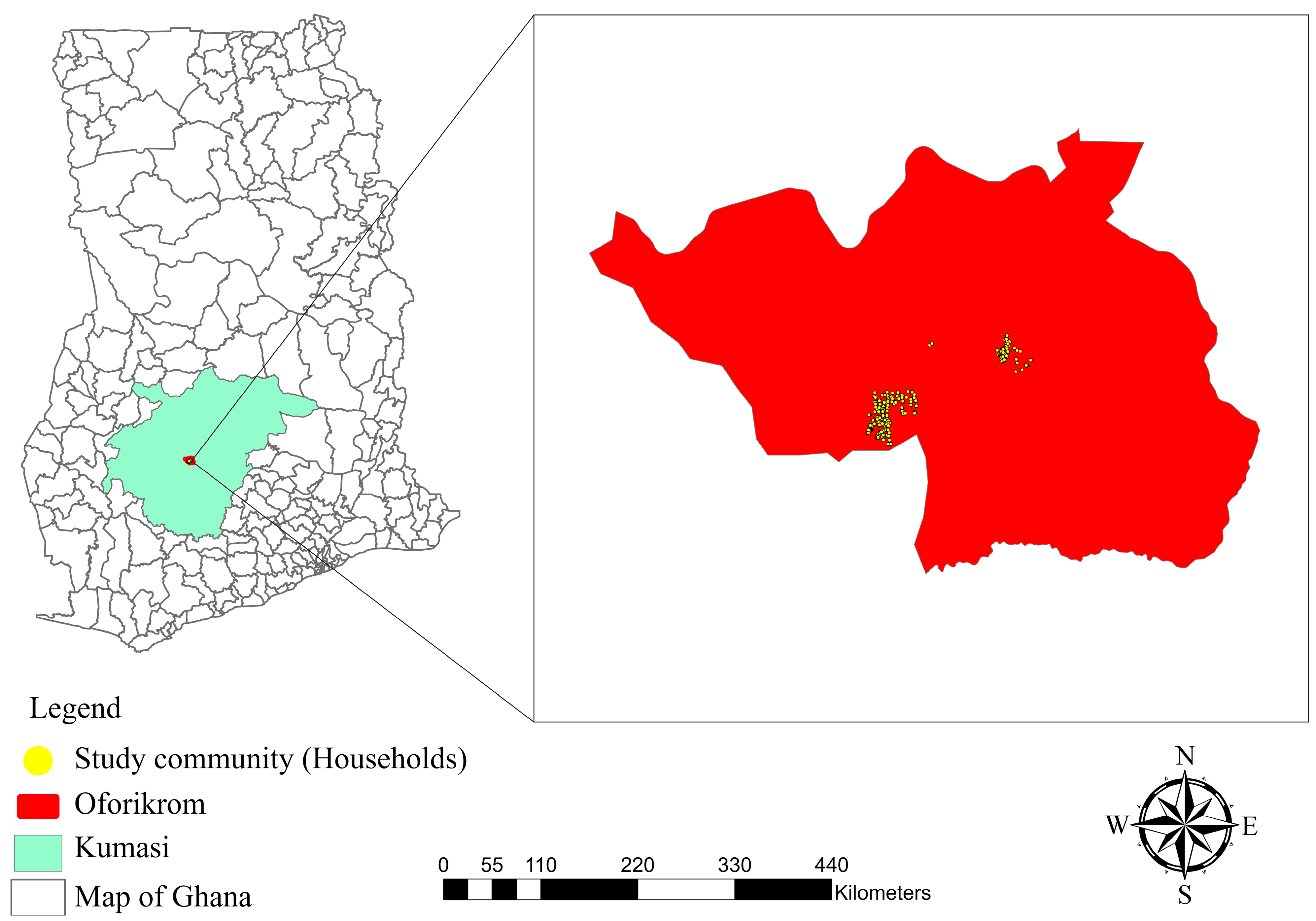
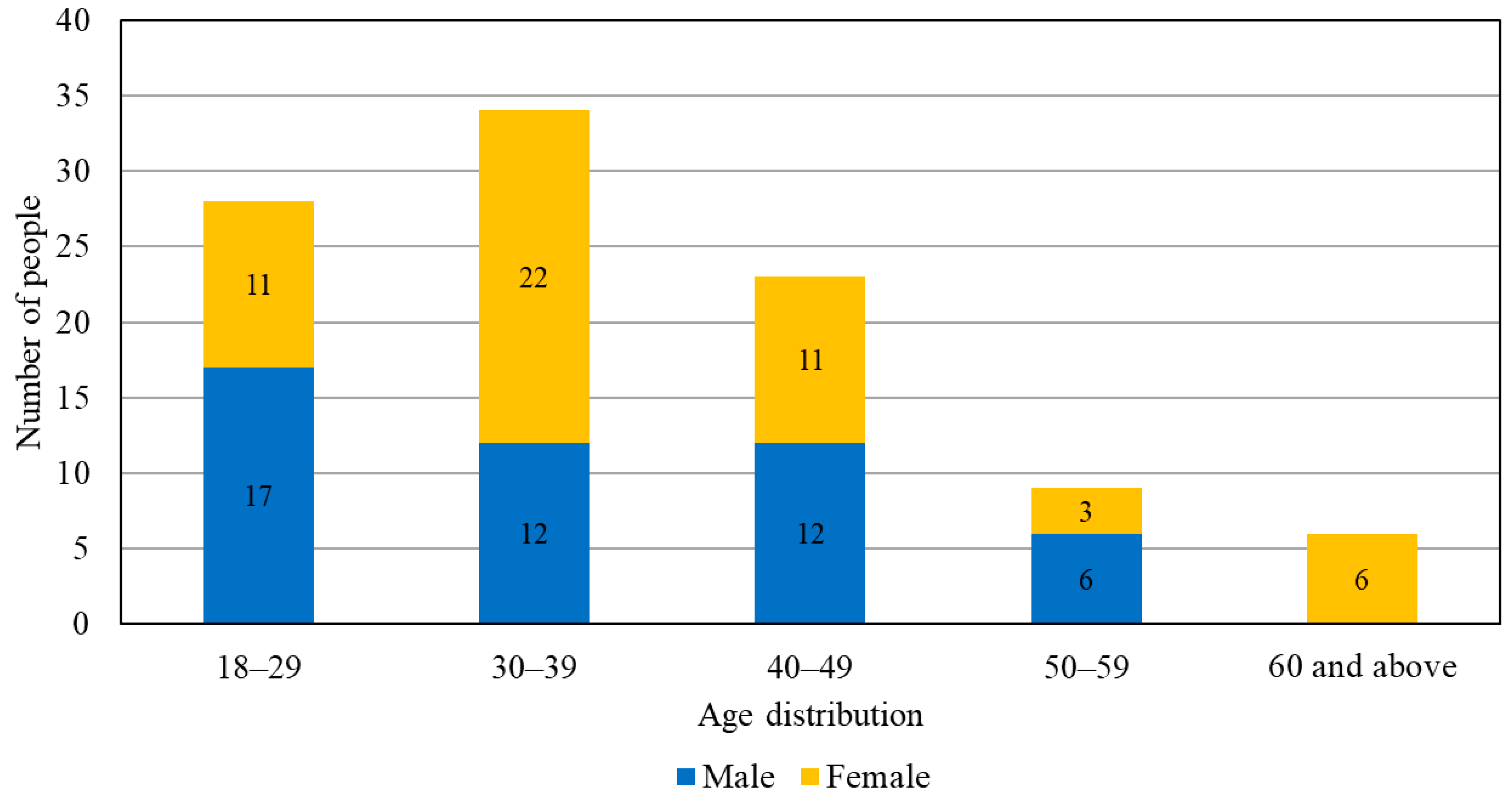
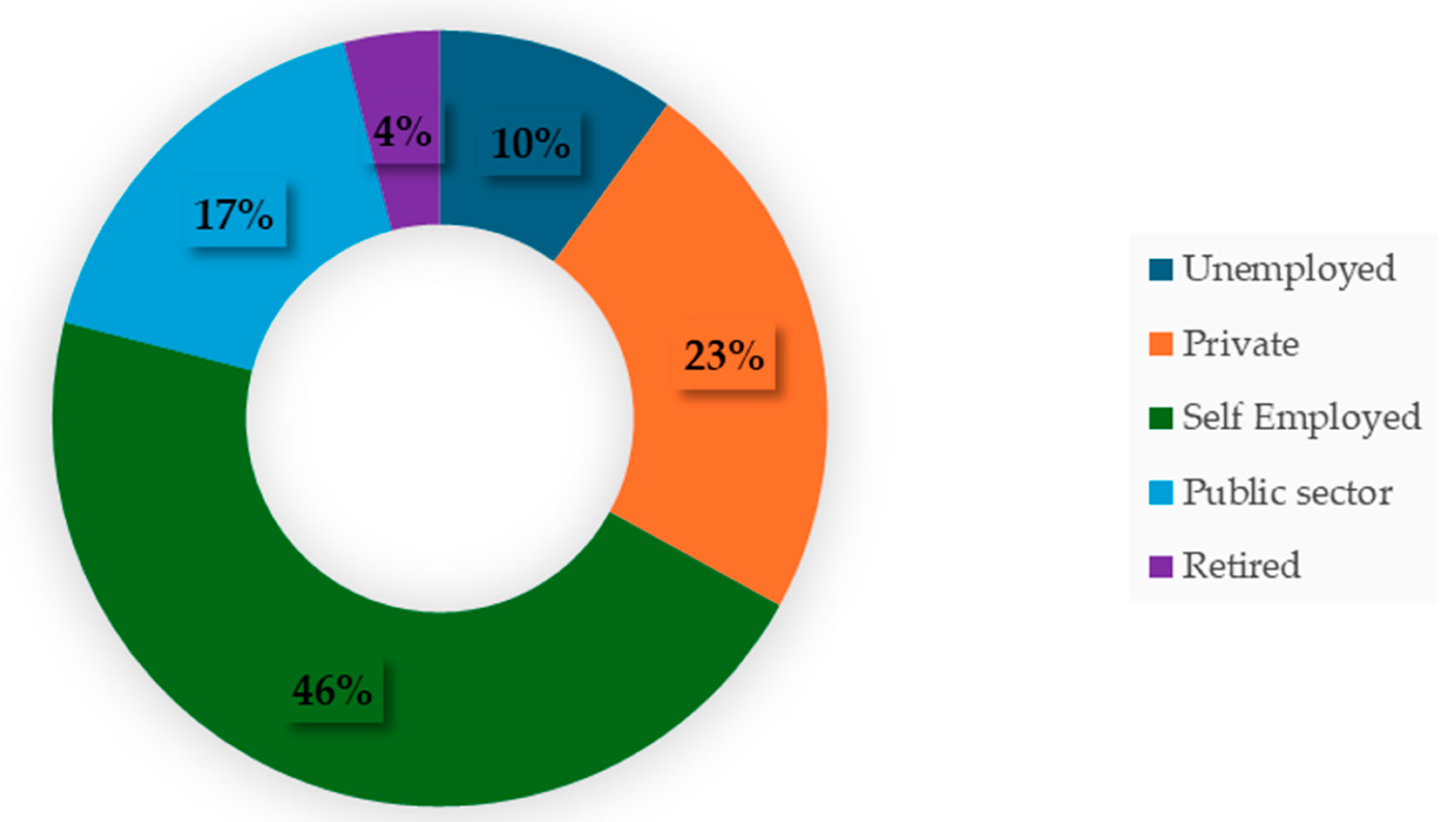
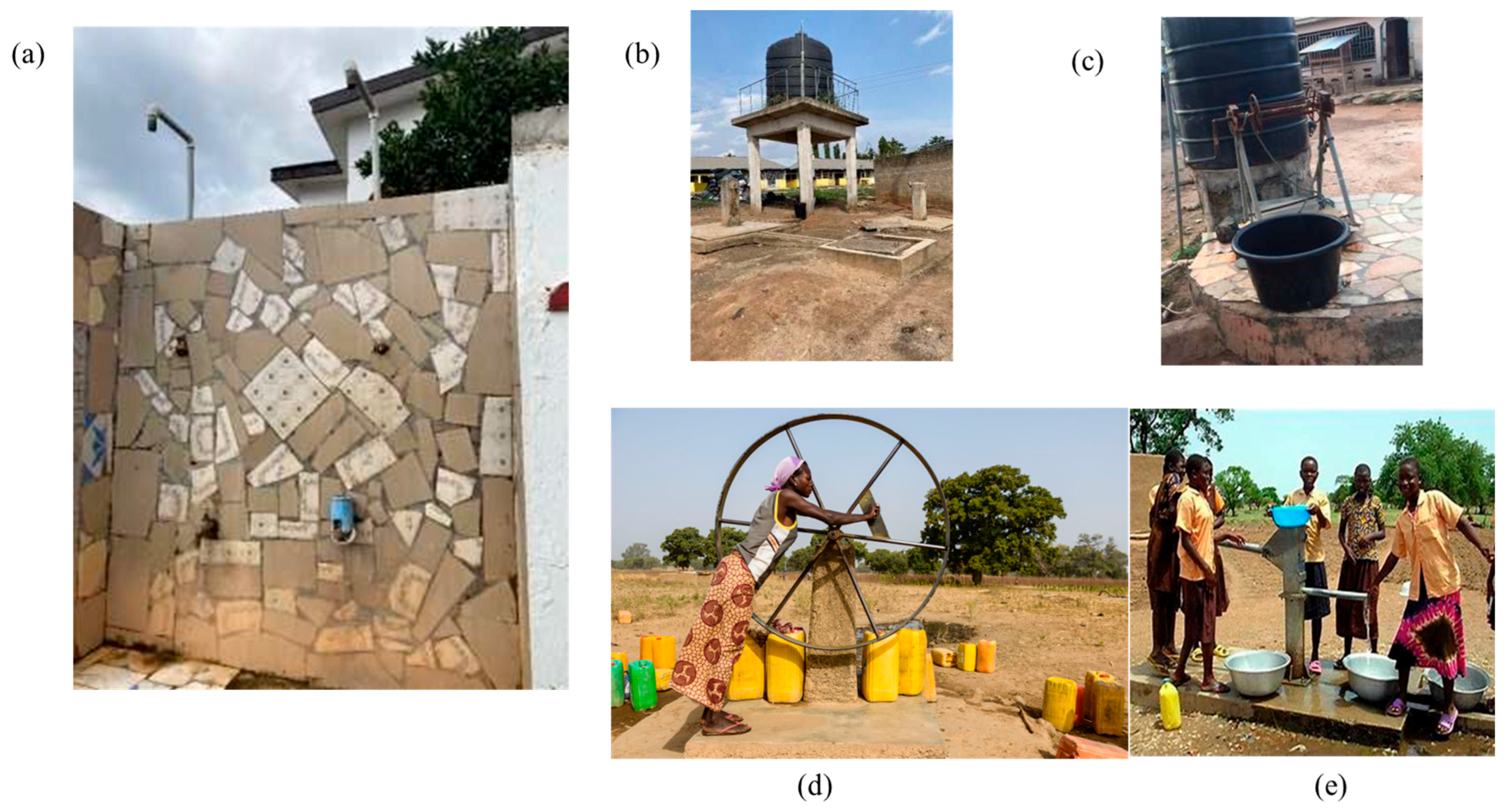

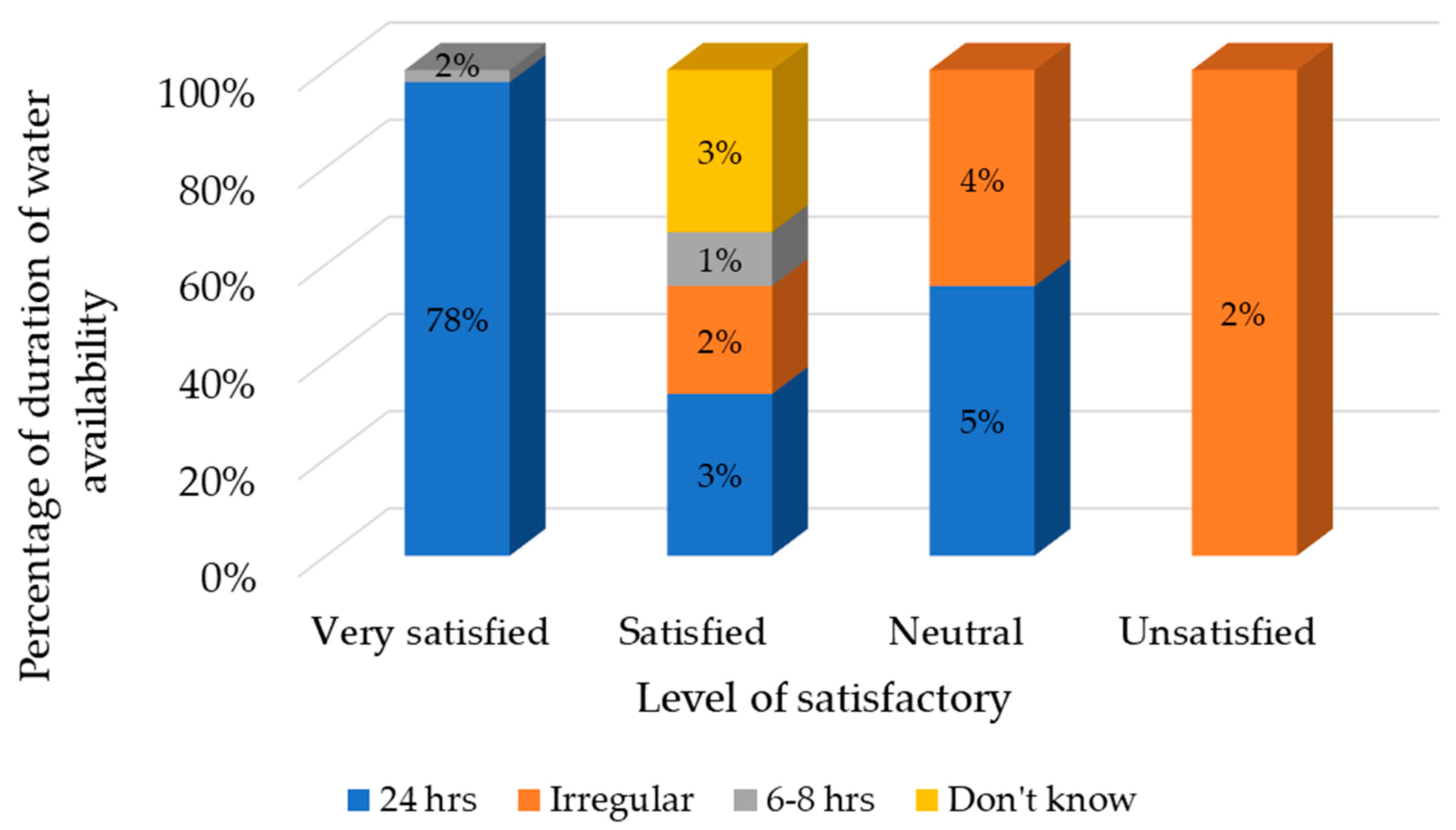
| Data | Information Obtained |
|---|---|
| Respondent Personal Information | Household location |
| Demographic characteristics | |
| Income of Household | Financial status |
| Educational status | |
| Household Asset | Financial status |
| Source of Household water | Improved/Unimproved Sources |
| Level of Service | |
| Level of Satisfaction | |
| Cost |
| Service Level | Definition |
|---|---|
| Safely managed | Drinking water from an improved source that is accessible on premises, available when needed and free from fecal and priority chemical contamination. |
| Basic | Drinking water from an improved source, provided the collection time is not more than 30 min for a round trip, including queuing. |
| Limited | Drinking water from an improved source, for which the collection time exceeds 30 min for a round trip, including queuing. |
| Unimproved | Drinking water from an unprotected dug well or unprotected spring. |
| Surface water | Drinking water directly from a river, dam, lake, pond, stream, canal or irrigation canal. |
| Typical Volumes of Water Used in the Home | Adequacy for Health Needs | Level of Health Concern |
|---|---|---|
| Average quantity more than 40 L/person/day | Drinking—assured Cooking—assured Hygiene—all food hygiene, handwashing, and face washing assured under non- outbreak conditions; enhanced hygiene during infectious disease outbreaks not assured; bathing and laundry at the home should also be assured. | Medium |
| Average quantity more than 100 L/person/day | Drinking—all needs met Cooking—all needs should be met Hygiene—all food hygiene, handwashing and face washing needs should be met, including for bathing and laundry at the home, and household cleaning. | Low |
| Region (District) | No of Communities | Total Point Systems | Non-Functional Systems | Non-Reliable Systems | % Of Functionality |
|---|---|---|---|---|---|
| Ashanti (Bosomtwe) | 10 | 26 | 4 | 5 | 85% |
| Northern (East Gonja) | 15 | 30 | 11 | 11 | 63% |
| Volta (Ketu South) | 6 | 19 | 7 | 13 | 63% |
| Total | 31 | 75 | 22 | 29 | 71% |
| Distribution of Occupation | |||||
|---|---|---|---|---|---|
| Level of Education | Self-Employed | Private | Public Sector | Unemployed | Retired |
| Tertiary | 7 | 10 | 13 | 6 | 1 |
| Senior High School | 19 | 5 | 1 | - | - |
| Junior High School/Middle School | 19 | 7 | 3 | 2 | 3 |
| Primary/ Elementary | 1 | 2 | - | 1 | - |
Disclaimer/Publisher’s Note: The statements, opinions and data contained in all publications are solely those of the individual author(s) and contributor(s) and not of MDPI and/or the editor(s). MDPI and/or the editor(s) disclaim responsibility for any injury to people or property resulting from any ideas, methods, instructions or products referred to in the content. |
© 2024 by the authors. Licensee MDPI, Basel, Switzerland. This article is an open access article distributed under the terms and conditions of the Creative Commons Attribution (CC BY) license (https://creativecommons.org/licenses/by/4.0/).
Share and Cite
Mantey, E.P.; Kanwar, R.S.; Appiah-Effah, E. Assessment of Water Service Levels and User Satisfaction for Domestic Water Use in Emina-Boadi-Kumasi to Achieve the Sustainable Development of Urban Water Supply Systems in Ghana. Water 2024, 16, 3193. https://doi.org/10.3390/w16223193
Mantey EP, Kanwar RS, Appiah-Effah E. Assessment of Water Service Levels and User Satisfaction for Domestic Water Use in Emina-Boadi-Kumasi to Achieve the Sustainable Development of Urban Water Supply Systems in Ghana. Water. 2024; 16(22):3193. https://doi.org/10.3390/w16223193
Chicago/Turabian StyleMantey, Emmanuel Padmore, Rameshwar S. Kanwar, and Eugene Appiah-Effah. 2024. "Assessment of Water Service Levels and User Satisfaction for Domestic Water Use in Emina-Boadi-Kumasi to Achieve the Sustainable Development of Urban Water Supply Systems in Ghana" Water 16, no. 22: 3193. https://doi.org/10.3390/w16223193
APA StyleMantey, E. P., Kanwar, R. S., & Appiah-Effah, E. (2024). Assessment of Water Service Levels and User Satisfaction for Domestic Water Use in Emina-Boadi-Kumasi to Achieve the Sustainable Development of Urban Water Supply Systems in Ghana. Water, 16(22), 3193. https://doi.org/10.3390/w16223193














